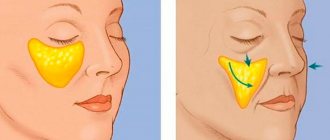Disability is a special group in which a person's ability to work is limited.
At the same time, the state provides the patient with certain benefits, social protection, provision of medicines and specialized treatment.
There may be a degree of disability at which one is allowed to work, but the conditions must be selected individually for the patient. To obtain a group, you must consult a doctor who conducts a full examination of the victim’s condition. The commission will give a verdict on the issuance of a certain degree after the conclusion of a specialist.
We recommend reading: Missing one eye - disability
Content:
- 1 Terminology
- 2 General provisions
- 3 Determination of disability
- 4 Features of disability in case of visual impairment
- 5 Assessing the capabilities of the visual analyzer
- 6 Degrees of low vision
- 7 Degrees of disability
- 8 Criteria for establishing disability groups
- 9 State and dynamics of disability
- 10 Primary disability of adults
- 11 Primary disability of children
- 12 Structure of visual disability
- 13 Rehabilitation of disabled people
Description
Pension amount
Persons with visual impairments are entitled to regular cash payments or other types of financial assistance provided for by social protection programs within the framework of pension legislation .
In 2021, the amount of pensions will be:
- disabled people of group 1 who have this status from the moment of birth, as well as disabled children - 11,646 rubles monthly;
- persons whose physical capabilities have been partially limited since childhood in group 2, as well as disabled people of group 1 who became disabled in adulthood - 9838 rubles;
- disabled people of the second group, with the exception of those who have had this status since childhood - 4,325 rubles monthly;
- third group - 4153 rubles per month.
These values are not fixed and are subject to indexation taking into account the increase in the average cost of living.
↑ Terminology
Disability
is a social insufficiency due to a health disorder with a persistent disorder of body functions, leading to limitation of life activity and the need for social protection.
Disability is a deviation from the norm of human activity due to a health disorder, which is characterized by a limitation in the ability to perform self-care, movement, orientation, communication, learning, work or control one’s behavior.
Status of a disabled person of the 1st group in terms of vision
Benefits for people with visual impairments of group 1 in 2021
To study the types of existing benefits, you need to consider the question of who can receive the status of a visually disabled person. This status is granted to the following categories of citizens:
- Persons with limited vision who cannot live and care for themselves at home or engage in labor activities;
- Completely blind people.
The causes of partial or complete loss of vision are:
- Exposure to ultraviolet rays;
- Received eye injuries;
- Bad ecology;
- Excess weight;
- Lack of microelements and beneficial vitamins, unbalanced diet;
- Work in hazardous production;
- Aging.
↑ General provisions
The main provisions of the modern concept of disability and state policy towards people with disabilities, corresponding to the norms of International law, are reflected in the Federal Law “On the social protection of people with disabilities and the Russian Federation” (No. 2181 of November 24, 1995).
According to this concept, when defining and interpreting disability
assess the social consequences of the disease (damage, defect) with an analysis of the main, sequentially related conditions that form disability:
* diseases:
* persistent dysfunction:
* life limitations;
* social insufficiency (disability).
Disability
is a multifactorial problem affecting human activity and his relationship with the social environment in conditions of limited freedom of choice due to health problems. An effective solution to this problem is one of the most important social tasks of the state, since disability, being an indicator of the health of the population, reflects the social maturity, economic viability and moral integrity of society.
The state of disability is determined mainly by the following factors:
* morbidity rates;
* demographic situation;
* socio-economic features:
* activities of healthcare and social protection institutions.
Benefits provided
The assistance program for the visually impaired includes assistance to:
- in purchasing medications;
- psychotherapist;
- social;
- economic.
Social protection is provided to every visually disabled person, and the state also assigns a pension. The amount of pension benefits depends on the disability group and is constantly indexed. Citizens of non-retirement age are entitled to social benefits, the amount of which depends on the sum of factors. These include the patient’s age, living conditions, economic component, ecology, etc. The amount of payments may change (increase/decrease) taking into account the listed factors.
Visually impaired people are entitled to free travel on public transport, and land and property taxes are reduced. To maintain health, the patient is given the opportunity to receive free treatment in sanatoriums and free purchase of certain medications.
↑ Determination of disability
Recognition of a person as disabled
is carried out by federal state institutions of medical and social examination (FGU MSE) based on the analysis of his clinical, functional, social, professional, labor and psychological data using classifications and criteria approved by the Ministry of Health and Social Development of the Russian Federation.
Depending on the degree of limitations in life activity caused by a persistent disorder of body functions, a citizen recognized as disabled is assigned disability group I, II or III, and a person under the age of 18 is assigned an additional category of “disabled child” (based on Government Decree of the Russian Federation No. 95 dated February 20, 2006 “On the procedure and conditions for recognizing a person as disabled” and Order of the Ministry of Health and Social Development of the Russian Federation No. 535 dated August 22, 2005 “On approval of classifications and criteria used in the implementation of medical and social examination of citizens of the Federal State Institution MSE”).
What to do in case of refusal
If the medical commission refuses to grant disability, and the person does not agree with this decision, he can appeal it.
It is required to send an application for re-examination to the bureau where the medical commission was carried out. A re-commission will be appointed in the main organization.
A citizen has the right to ask in writing to convene another commission to resolve the disability issue. He also has the right to conduct a second commission at the federal bureau.
After a citizen submits an application for a re-examination, it will take place within one month.
Attention: If the repeated commission also refuses to assign a disability, you can appeal the decision in court.
↑ Features of disability in case of visual impairment
Determining the presence and severity of disability due to pathology of the organ of vision
is based on the general provisions of medical and social examination, but has specific features. This uniqueness is due to the uniqueness of vision, which is of paramount importance among other sensory systems in the implementation of the entire complex of integrated human activities.
• The variety of visual disorders makes it necessary to conduct a comprehensive analysis of their impact on life activities and assess the social consequences of visual impairments. The algorithm for such an analysis in expert rehabilitation diagnostics includes consideration and assessment of a set of general and special clinical and functional characteristics of the organ of vision in its pathology, including data from electrophysiological and psychophysical studies. • It is important to evaluate the degree of adaptation to the visual defect and the possibility of activating other analyzing systems to compensate for it.
• It is necessary to take into account concomitant pathology, assess the clinical prognosis, the possibility and effectiveness of restorative treatment, vision correction, determine the psychological characteristics of the individual, analyze social, social, environmental, professional and labor factors, rehabilitation prognosis and the possibility of its implementation in specific social conditions.
Obtaining a referral for a medical and social examination
In order to begin the procedure for registering visual disability, you first need to be examined by an ophthalmologist, and it does not matter whether he works in a public or private clinic. A medical organization of any organizational and legal form can give a referral for a medical and social examination.
The main purpose of the examination is to obtain a referral for examination. But in addition to medical institutions, both the social security authority and the Pension Fund of the Russian Federation can refer a citizen to MSE. A medical organization refers a citizen to medical examination after diagnosis and treatment, when the doctor has determined that the citizen has partial or complete blindness, which prevents him from living a full life. And the social protection authorities and the Pension Fund of the Russian Federation give a referral to a person who has medical documents confirming the presence of diseases of the organs of vision when they see that the citizen is in need of state assistance and protection.
If all of the listed bodies refused to give a citizen a referral to undergo an examination, then the citizen has the right to demand that he be issued a certificate confirming that he applied to receive a referral, but was refused to issue it. With this certificate, the citizen himself can contact the body conducting the examination. There they examine him and decide whether an examination is really necessary.
↑ Assessment of the capabilities of the visual analyzer
Visual impairment has an adverse impact on the usefulness of almost all categories of life, but the degree of this impact varies.
• A person’s ability to move, self-care, orientation, communication
mainly depends on the state of basic visual functions - visual acuity and field of vision. In the process of medical and social examination, visual functions are determined by mono- and binocular presentation of test tests, but the degree of their impairments, which influence the determination of the presence and severity of disability, is assessed primarily by the state of functions of the better-seeing or only eye under conditions of tolerable (optimal) correction.
•Capabilities of the visual analyzer
in relation to specific tasks of work and training, it is more difficult to characterize: in addition to analyzing visual acuity and field, it is necessary to evaluate other functions of the organ of vision that are significant for performing various types of work (including visual work) or vocational training. These functions include light sensitivity (dark adaptation), color perception, binocular vision, near visual acuity and accommodation.
• For ametropia, anisometropia, diseases of the central nervous system (CNS) and pathology of the visual-nervous system
determine visual fatigue, visual productivity and other ophthalmic-ergonomic characteristics, since sometimes even with relatively good indicators of visual acuity and field of vision, the presence of pathological visual fatigue or low visual productivity reduces the possibility of working in visual work.
Prevention methods for adults and children
Preventive measures for astigmatism include following the rules of visual hygiene; this helps protect the eyes from unnecessary stress and, to some extent, prevent the formation and development of dangerous complications.
- Perform any visual work in sufficient and uniform lighting.
- Alternate visual stress with physical exercise, take breaks from watching TV shows, working at the computer, reading, sewing, etc.
- Do eye exercises.
- Try to minimize the impact of unfavorable climatic conditions - such as cold, frost, wind (especially with sand or dust) - anything that can cause eye irritation.
More detailed individual recommendations can be obtained during a face-to-face appointment with an ophthalmologist. The doctor will tell you what needs to be done to prevent the deterioration of the visual organs in accordance with the type of astigmatism, its degree, the general condition of the visual system and the patient’s age.
In the case of a hereditary predisposition to this ophthalmological pathology, doctors recommend devoting sufficient time to prevention.
Important
The issue of prevention and control of this disorder is especially relevant for patients who are at risk due to age or heredity.
If the disease does not manifest itself immediately after birth, this does not mean that it will not appear at a later age. It should also be noted that the prevention of astigmatism in adults and children has some differences.
Doctors insist that the best prevention of impaired optical function is to reduce the load on the visual organs. For detailed advice on methods of preventing pathology, you should immediately contact an ophthalmologist, who will share recommendations that are adequate in a particular case.
As a rule, the ophthalmologist advises:
- Taking complex fortified preparations to maintain the functioning of the visual apparatus.
- If the work requires prolonged concentration of the eyes (at the computer or reading, when working with small details), then special gymnastics is prescribed to relieve tension in the eyes.
- Ensure adequate lighting when reading or working at the computer.
- Taking a course of physiotherapy.
- For people predisposed to ophthalmological diseases, it is harmful to read in transport, to work for a long time at a computer, tablet or other means of technological progress of a similar type.
- It is especially dangerous to use these things in the dark, with only illumination from the monitor backlight.
- Fact: By following such simple recommendations, you can delay the onset of the disease, and with regular maintenance of this regimen, even prevent it.
Prevention methods for children:
- To prevent astigmatism in young patients, it is enough to follow the rules that are recommended for adults.
- The only difference is that parents must monitor the child’s compliance with preventive measures.
Parents should not allow prolonged contact with very small objects and prolonged use of equipment that requires visual perception:
- computer;
- TV;
- tablet, etc.
A child may outgrow astigmatism, since before adolescence the visual organs are still developing and adjusting. This gives the baby an advantage over the adult.
But if congenital astigmatism, which can affect even infants, is not treated, after a few years the pathology can transform into amblyopia or strabismus.
↑ Degrees of low vision
According to ICD-10, the severity of dysfunction of the visual analyzer is divided into 4 degrees: I degree
(minor degree of low vision) - minor dysfunction;
II degree
(moderate degree of low vision) - moderate dysfunction:
III degree
(high degree of low vision) severe functional impairment;
IV degree
(practical or absolute blindness) significant functional impairment.
The criteria for assessing impairment of basic visual functions when determining disability are given in Table. 1.
Benefits and compensation for visually impaired people of group 1 in 2018
Every disabled person of group 1, regardless of the cause and type of disability, is endowed by the state with the right to receive benefits. Let's take a closer look at them.
Pension for disabled people of group 1
Benefits and compensation for visually impaired people of group 1 in 2018 are paid monthly in the form of a pension. The amount of such a pension is calculated based on the following factors:
- On the degree of vision loss, that is, the assigned disability group;
- Type of assigned pension;
- Assigned special status.
↑ Degrees of disability
Assessment of disability has its own characteristics for each category of life activity, but there are also basic (common to most categories) characteristics. All disabilities are divided into three degrees depending on severity.
• First degree restrictions
occur when the patient is able to independently carry out one or another type of life activity, but with certain difficulties (longer time, reduced volume, fragmented execution, etc.) and, if necessary, with the use of auxiliary aids in connection with moderate persistent dysfunction.
•Second degree restrictions
arise when it is necessary not only to use auxiliary aids, but also regular partial assistance from another person or specially created conditions (for training or work), which is due to persistent severe dysfunction.
•Third degree restrictions
determined by the complete inability of the patient to independently carry out the main categories of life activity, his need for constant outside assistance and complete dependence on other persons due to significantly pronounced persistent dysfunction.
Preparation of documents and sending to ITU
To register a visual disability, the patient or his relatives must contact an ophthalmologist at an institution licensed to conduct a disability examination, regardless of its form of ownership. The doctor will conduct an examination and, if necessary, refer you to other specialists (neurologist, endocrinologist, therapist or pediatrician, surgeon, oncologist, geneticist), and also give recommendations on the necessary instrumental diagnostics.
A complete examination of the patient is necessary to provide information to the ITU about disorders in other organ systems to assess the overall disability and rehabilitation potential. Persons of working age who contracted the disease at work or during military service are given a certificate for submission to the commission.
The list of documents for ITU varies depending on the age and work status of the patient
ITU is preparing:
- referral to a commission of the established form;
- statement of the patient or his guardian;
- passport/birth certificate;
- medical policy and SNILS;
- a copy of the work book;
- discharge from a medical institution.
When registering a disability, a child needs a passport and a copy of the caregiver’s employment record.
The period for which a pension is issued depends on the reversibility of changes in the organ of vision and the severity of social maladjustment. The child undergoes re-examination annually, once every 2 years, or receives disability until adulthood. Upon reaching 18 years of age, he is sent from the children's ITU to the adult commission and decides whether there are signs of disability and what group he will be given. When applying for disability, disabled citizens should undergo a full examination. This will help “pull” them into a higher group based on the totality of signs of disability.
↑ Criteria for establishing disability groups
One of three disability groups
is established based on the severity of health impairments, the degree of persistent functional disorders and limitations in life activity, as well as the need for social protection and assistance measures.
•Disability of the first group
determined in cases of health impairment with a persistent, significantly expressed disorder of body functions, leading to limitation of the main categories of life activity of the third degree. For persons with visual impairments, the first disability group is established in the presence of practical or absolute blindness in both eyes (IV degree of visual impairment), which, in combination with other medical and social factors, causes restriction of the main categories of life activity of the III degree.
•Disability of the second group
established in cases of health impairment with a persistent pronounced disorder of body functions, leading to limitation of the main categories of life activity of the 2nd degree and (or) the ability to learn and work of the 2nd or 3rd degree. In case of visual impairment, the indication for determining the second disability group is the presence of a high degree of low vision in the only or better seeing eye or in both eyes (III degree of visual impairment), which, taking into account social factors, leads to II degree of restrictions on the ability to carry out the above types of life activities.
• Disability of the third group
are determined in case of health impairment with a moderately severe functional disorder, leading to a limitation of the ability to work of the 1st degree or a limitation of other categories of life activity of the 1st degree. For persons with visual impairments, disability of the third group is established when the ability to work professional activities is limited to the first degree, caused by moderate vision impairment (second degree of visual impairment) or, in special cases, of a small degree (I degree of visual impairment), which in combination with social characteristics determine the limitation of several other categories of life activity of the first degree.
Astigmatism and myopia
Often astigmatism accompanies another refractive error - myopia. When combined, these diseases can cause serious discomfort.
Standard optical correction does not provide optimal visual performance; special spherocylindrical glasses or toric contact lenses are required. The optimal solution in this case is laser vision correction.
Postoperative astigmatism is a common phenomenon after microsurgical interventions, when the spherical shape of the cornea is disrupted after surgery. In some cases, it is possible to eliminate postoperative astigmatism using laser vision correction.
However, modern surgical techniques, for example, cataract removal, make it possible to reduce the risk of postoperative astigmatism to a minimum or avoid it altogether.
↑ State and dynamics of disability
Despite significant advances in clinical ophthalmology, especially ophthalmic surgery, the prevalence of disability due to visual impairment among the population of the Russian Federation in 2000-2005.
remains high. The accumulated contingent includes 600.0 thousand visually impaired people, of which 60.6% are people of retirement age, 22% are young, and 17.4% are middle-aged. The level of general disability varies in different age groups from 5.5 among people under 18 years of age to 104.0 among the population over 60 years of age, amounting to 16.1 (per 10,000 of the corresponding population) among people of working age. During the initial examination, in 34.3% of cases, group III is established, in 41.7% - group II and in 24.0% - group I disability (in the contingent of people of retirement age, groups I and II are determined in 86.4% of cases). In dynamics, an increase in the severity of disability is observed: in the contingent of re-examined disabled people, persons with disability group I make up 40%, with group II 38% and with group III 22% (the severity indicator reaches 28%). These data indicate the extremely low effectiveness of rehabilitation measures.
Re-examination
If a temporary disability status has been given, the citizen is required to undergo re-examination. This is due to the fact that the state of health can change in one direction or another - deterioration, improvement. Lifelong disability is given only in the case of irreversible processes, when there is no chance of restoring visual functionality. Re-examination must be completed in advance, otherwise the status of a disabled person loses its legitimacy.
You need to do the following;
- collect the necessary documents;
- provide a report on the completion of medical procedures;
- submit documents to the regional ITU;
- appear before the commission at the appointed time.
After the recommission, a citizen may lose his disabled status or receive a new group. As a result, re-examination may affect the amount of social benefits/pension.
The reason for re-examination may be a statement from a citizen who disagrees with the decision of the previous commission to determine disability. However, such an event occurs only on the basis of a court decision if the judge considers the applicant’s claim to be legal.
Also, an unscheduled commission is appointed:
- when there is a sharp change in the disabled person’s condition towards improvement;
- when initiating control checks by higher organizations.
Sometimes the reason for recommission is the personal circumstances of the disabled person.
Recommissions are carried out at the regional ITU bureau, and in the case of a claim, at a higher bureau. If a citizen is undergoing treatment, the examination is carried out in a hospital or in the patient’s apartment.
Required documents for recommission:
- passport of a citizen of the Russian Federation - original, photocopy;
- disability certificate;
- patient's medical record;
- certificate from place of work/study;
- salary certificate subject to employment.
If a citizen works, a document on working conditions is required.
Women after 55 years of age and men after 60 years of age do not undergo re-examination.
The timing of recommissions differs for different groups. In order not to miss the re-examination time, you need to keep in touch with ITU representatives. Disabled people of the third and second groups undergo a medical examination annually.
After reaching the age of 18, a disabled person is assigned an adult category, and re-examination takes place at the ITU bureau for adults.
↑ Primary disability of adults
Negative dynamics of the main indicators of disability in 2000 - 2005 was established.
with an increase in the number of people newly recognized as disabled from 39,000 to 66,700 people per year and an increase in the level of primary disability from 3.1 (2000) and 3.5 (2004) to 5.8 (2005) per 10,000 adults. The prevalence of primary disability is not the same in different federal districts (in the Central - 5.4, in the Volga - 7.9, in the Far Eastern - 4.5, in the Southern - 6.0, in the North-Western - 4.2, in the Ural - 5.3 , in Siberian 5.1 per 10,000 adult population) and constituent entities of the Russian Federation, where it varies from 1.5 in Moscow to 20.5 in the Republic of Kalmykia per 10,000 adult population.
The highest incidence of primary disability is among the retirement age population (18.2), which is significantly higher than the same indicator for middle-aged (3.4) and young (1.0 per 10,000 of the corresponding population) people. Among adults with a newly diagnosed disability, patients of retirement age make up 79.8%, and those of working age make up 20.2%.
Symptoms
It is important to pay attention in time to alarming symptoms that indicate that you need to visit an ophthalmologist as soon as possible.
The presence of astigmatism may be indicated by:
- feeling of “sand” and burning in the eyes;
- redness of the eyes;
- double vision and distortion of visual images;
- inability to focus your gaze;
- difficulties with orientation in space, determining the distance to objects;
- rapid eye fatigue during visual work such as reading, watching TV, working at the computer, sewing, etc.;
- drop in visual acuity;
- pain in the area of the brow ridges;
- frequent headaches.
Symptoms of the disease can be pronounced or barely noticeable. Only a specialist can reliably determine whether something threatens vision. Don't neglect routine diagnostic examinations! Adults should visit an ophthalmology clinic at least once a year, children - at the age of 3-12 months, 3, 5, 7 years and then annually.
↑ Primary disability of children
Prevalence of primary disability in children
due to visual impairment in the Russian Federation in 2000-2005. amounted to 1.4 per 10,000 children, with fluctuations in this indicator both in various federal districts (from 0.8 in the Northwestern and Ural to 2.8 per 10,000 children and the Southern), and in individual subjects of the Federation (from 0. 1 in the Novosibirsk and Kemerovo regions to 26.4 per 10,000 children in the Chechen Republic and Dagestan).
Every year, more than 4,000 children are diagnosed with visual impairment in the Russian Federation. It should also be taken into account that 21% of disabled people developed visual disorders in childhood. The level of primary disability is highest in the age group of children from 4 to 7 years, especially among boys.
Rehabilitation activities
Conditions should be provided for visually impaired people to help make their movement around the city safe. Creating an accessible environment means:
- Installation of relief guides on the surface of sidewalks in the direction of travel.
- Contrasting color markings for the edges of sidewalks and subway platforms for visually impaired people.
- Marking the first and last steps of each flight of stairs with color and relief tiles.
- Using a standard step size
- Contrasting marking for double-leaf glass doors.
- Using Braille signs at hand level for a disabled person to duplicate information about streets, house numbers, names of institutions, and public transport stops.
- Providing traffic light objects with sound signals.
Education for disabled children is organized in special boarding schools. Subsequent vocational training for disabled people is carried out by the All-Russian Society of the Blind. It also provides jobs for people with disabilities in specially created conditions. Popular professions include: massage therapist, call center operator, programmer, dispatcher.
The ability of a blind person to move freely makes it possible to lead an active lifestyle
Adults with disabilities of groups 1 and 2 can receive treatment, medical, social and psychological rehabilitation in a specialized medical and preventive institution. In the Russian Federation, the State Budgetary Institution “Boarding House for the Visually Impaired” in Moscow is popular.
↑ Structure of visual disability
The main causes of disabling visual disorders
over the last five years:
* among the adult population
- glaucoma (28%), consequences of injuries to the organ of vision (16%), degenerative myopia (19%), diseases of the vascular tract, retina and optic nerve (15%), pathology of the lens (12%);
* refractive errors among children
(26.4%), congenital cataracts (17.3%), retinopathy of prematurity and other retinal pathologies (16.6%), diseases of the optic nerve (12.0%), eye injuries (10.5%), malformations (5.3%) and glaucoma (3.8).
Glaucoma
. The share of glaucoma among the causes of primary disability in the Russian Federation increased over 5 years (from 2000 to 2005) from 20 to 28%, and the prevalence - from 0.15 to 0.60 per 10,000 adults. Among the causes of visual disability in people beyond retirement age, the proportion of glaucoma reaches 40%. In 81.2% of cases, persons with glaucoma are assigned disability group I or II already during the initial examination, which indicates a late diagnosis of the disease.
Refractive errors.
Among refractive errors that lead to disability in adults, high-degree degenerative myopia prevails. The prevalence of disability due to myopia is 4.5 (including primary disability - 0.6) per 10,000 adults. The majority (64.0%) of people in this contingent are disabled people of group III of working age.
Diseases of the vascular tract, retina and optic nerve.
Significant severity of disability is observed in patients with various forms of eye damage due to diabetes mellitus (DM) and taperetinal abiotrophy, as well as disabled people with age-related macular degeneration. In 93-97% of them, during the initial examination, disability group I or II is established.
Consequences of injuries to the organ of vision.
The share of this pathology in the nosological structure of visual disability decreased from 16.3% in 2000 to 3.9% in 2005. The most important is domestic trauma (70.5%, including 21.7% - criminal).
Among the disabled due to eye injury, 88% of group III disabled people are young. The main disabling outcomes of eye injuries are corneal scars (27.2%), anophthalmos (26.3%). traumatic cataract (5.4%), complicated aphakia or pseudophakia (1.6%), subatrophy of the eyeball (10.7%), traumatic detachment and other retinal changes (12%), optic nerve atrophy (9%). Pathologies of the lens.
The share of lens pathology among the causes of visual disability is 12-18%. The main clinical variants leading to disability are various types of cataracts (26%), complicated aphakia (17%) and complicated pseudophakia (57%). Pathology of the lens in 5% of cases leads to disability of group I, in 35% to disability of group I and in 60% to disability of group III.
Visual functions and assessment of their impairments
When describing the state of vision, the following parameters (or functions) are analyzed:
| Characteristic name | Description |
| Central vision | Designed to distinguish small objects and parts. Characterizes visual acuity, designation - Vis, usually the interval is from 0 to 1, the normal value is 1. When measuring Vis, a certain number of diopters (Dopters) corresponds. |
| Peripheral vision | Characterizes the space that is located on the sides of the point at which the gaze is fixed (field of vision). Normal values (in degrees) are: up to 90 outward, up to 50 upward and inward, up to 70 downward. |
| Color vision | The ability to perceive different colors, their saturation and brightness. |
| Binocular vision | Describes the coordinated work of both organs of vision, due to which a correct picture of the world is formed in the cortical part of the analyzer. This parameter helps to clearly determine the localization of an object, its three-dimensionality, and affects the acuity and width of the visual field. |
| Light perception | Associated with the ability of the eye to perceive light, distinguish between its degrees of brightness, adaptation to different conditions - darkness and light. |
Disturbances in each of the functions can be caused by damage to various components of the eye and analyzer: muscles, retina, cornea, tumor growth, hemorrhage, trauma, hereditary pathology.
Visual acuity and size of visual fields are the main characteristics that are assessed when referring for disability
There are several types of diseases of the visual analyzer:
- congenital pathologies;
- age-related visual impairment;
- industrial and military injuries;
- various diseases of the eyeball.
Compensation under housing legislation
All visually impaired people of group 1 who need improved housing conditions can apply for expansion and provision of housing. Disabled people who registered before 2005 have priority, regardless of the type of budget.
There are a number of federal programs operating on the territory of the Russian Federation that empower local administrations to provide housing for people with disabilities and pay utility bills. The amount of assistance provided by the local budget depends on the following factors:
- Standard cost of utilities per sq.m. in a specific region;
- Local living space standards;
- Minimum contribution for the renovation of an apartment building;
- Average market value sq.m. housing;
- Number of disabled people entitled to social assistance.
Next, we will consider in detail what types of benefits are provided to visually impaired people of group 1 in the housing sector:
- Disabled people living in social institutions who apply for housing under a social tenancy agreement have the right to register regardless of the size of the space they occupy in such institutions;
- A person may be allocated premises that are twice the minimum size of 18 sq.m.;
- The premises provided to a disabled person must be specially equipped to meet his requirements and needs;
- Disabled people and families with disabled children are provided with a 50% discount on utility bills, regardless of the type of housing and ownership of it, and the provision of fuel due to the lack of centralized heating.
- Disabled orphans, upon reaching the age of 18, should be provided with housing out of turn if they are able to live independently without outside help;
- Families with disabled people, single disabled people who have the opportunity to run a household, are given priority land plots for running their own household or individual construction;
- If a disabled person is placed in a social service institution, the living space of state or local funds, which is assigned to him on the basis of a social tenancy agreement, is retained by him for six months.
In order to take advantage of the benefits and compensation provided by the state for visually impaired people of group 1, you must first obtain a disability and study in detail all the features of existing programs at the local level. Each region implements programs that provide special types of benefits, assistance and compensation for the visually impaired, based on the financial capabilities of the local budget.
Rate the quality of the article. Your opinion is important to us:
You can get an answer to your question by calling the numbers ⇓
Free consultation Moscow, Moscow region call: +7
One-click call
St. Petersburg, Leningrad region call:
+7 One-click call
Employment of people with visual impairments of group 1
In the Russian Federation there is a Russian Society of the Blind, in which this category of disabled people works. They are mainly involved in packaging and assembling various products. However, there are absolutely no restrictions regarding the choice of profession. They can also work in various service sectors, for example, legal, creative, educational, medical and other professions.
For enterprises, a special quota has been established for the number of disabled people who must be on staff with the right to reduce the tax burden. There are also various organizations of people with disabilities, whose activities are aimed at protecting and guaranteeing their rights. Such organizations are provided with:
- Exemption from payment of land tax if it was created in the interests of protecting the rights of people with disabilities and operates in accordance with the charter;
- The registration fee for such an organization has been reduced;
- Benefits for paying state fees when carrying out notarial acts.











